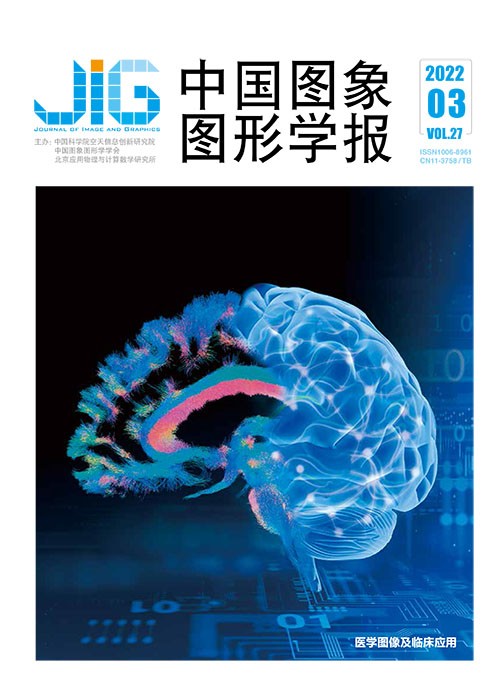
融入平滑组稀疏化的脑部MRI图像分类
摘 要
目的 阿尔茨海默症(Alzheimer’s disease,AD)是主要的老年病之一,并正向年轻化发展。早期通过核磁共振(magnetic resonance imaging,MRI)图像识别AD的发病阶段,有助于在AD初期及时采取相关干预措施和治疗手段,控制和延缓AD疾病恶化。为此,提出了基于平滑函数的组L1/2稀疏正则化(smooth group L1/2,SGL1/2)方法。方法 通过引入平滑组L1/2正则化实现组内稀疏,并将原先组L1/2方法中含有的非平滑的绝对值函数向平滑函数逼近,解决了组L1/2方法中数值计算振荡和收敛难的缺点。SGL1/2方法能够在保持分类精度的前提下,加速对模型的求解。同时在分类方法中,引入一个校准hinge函数(calibrated hinge,Chinge)代替标准支持向量机(support vector machine,SVM)中的hinge函数,形成校准SVM (calibrated SVM,C-SVM)用于疾病的分类,使处于分类平面附近的样本更倾向于分类的正确一侧,对一些难以区分的样本能够进行更好的分类。结果 与其他组级别上的正则化方法相比,SGL1/2与校准支持向量机结合的分类模型对AD的识别具有更高的分类性能,分类准确率高达94.70%。结论 本文提出的组稀疏分类模型,实现了组间稀疏和组内稀疏的优点,为未来AD的自动诊断提供了客观参照。
关键词
Brain MRI image classification incorporating smooth group sparseness
Huang Shuaihui, Wang Jinfeng(College of Mathematics and Informatics, South China Agricultural University, Guangzhou 510642, China) Abstract
Objective Alzheimer's disease (AD) is one of the most common irreversible neurodegenerative diseases. The main clinical manifestation is cognitive impairment, which usually occurs in the middle-aged and elderly stage. The diagnosis and recognition of AD is constrained of the inefficient experience and mis-diagnosis of clinicians. If the onset stage of AD can be targeted in early diagnosis, it will yield relevant interference and treatment measures to the early stage of AD. A high accuracy automatic detection algorithm will help clinicians to prevent and treat AD. Method Structured magnetic resonance imaging (S-MRI) is used to extract gray matter density characteristics of each subject after pre-treatment. A group L1/2 sparsity method based on smoothing function (SGL1/2) is illustrated. This smooth grouping sparsity method is based on the common group L1/2 (GL1/2) method. GL1/2 method can aid Group Lasso method to select high correlation feature group without sparse the selected feature group, so it can remove some redundant features in redundant group and surviving group simultaneously. However, this group sparsity method has the difficulties of oscillation and convergence because it contains non-smooth absolute value function. The selected SGL1/2 method uses a smooth function to approximate the non-smooth absolute value function of the traditional GL1/2 method. The sparse model becomes a smooth model, which can quickly converge to the optimal value. Meanwhile, these regularization benchmark need to group features in advance at the group scale. In order to obtain scientific grouping of human brain features, a registered anatomical automatic labeling (AAL) template, which registers the original AAL template into the standard template, so that the obtained AAL template has the same spatial distribution as each pre-processed targeting image. Based on this grouping template, each region is regarded as a group. All voxels in each region are targeted as the features of each group for group sparing. In respect of classification method, a calibrated hinge is opted to substitute the hinge loss function in SVM (calibrated SVM, C-SVM). C-SVM can make the points near the classification plane more inclined to the correct side of the classification. We select four classification methods, which are support vector machine (SVM), calibrated support vector machine (C-SVM), linear classification and logistic regression. C-SVM uses a calibrated hinge loss function to replace the hinge loss function of traditional support vector machine, and then classifies the features of AD and cognitive normal (CN) control group via a simple classification function. The analyzed results illustrates that the classification accuracy of C-SVM reaches 91.06%. We select C-SVM as the benchmark, and the SGL1/2 group sparse method is integrated based on registered AAL template to form the main classification method. Result The key demonstration is selected from the "ADNI1:Complete 2Yr 1.5T" dataset of Alzheimer's disease neuroimaging initiative (ADNI) for training and testing, and compared the classification performance with the classification model combined with GL1/2 and SGL1/2 group level regularization methods. The calibration support vector machine classification model has a good classification effect on the recognition of AD based on SGL1/2 group sparsity method. In the control group of AD and CN control group, the classification accuracy reaches 94.70%. In order to show the generalization of the model, we also selected Cuingnet data sets from relevant for classification literatures. The results also confirmed that the illustrated model had qualified classification effect. In the control group of AD and CN, the accuracy rate reached 91.97%. In terms of the features of each group segmented by the registered AAL group template, the C-SVM model is used to classify, and the classification effect of each group region is obtained. We select six regions with the best classification effect, and compare the results of the targeted illustrated model. Conclusion The demonstrated SGL1/2 group sparse classification model is based on AAL grouping template proposed in this research. The priorities of inter group sparse and intra group sparse are evolved. The high correlation features of high correlation group are selected in all human brain regions, and realize the accurate location of high correlation brain regions with AD, which provides a benchmark for the automatic diagnosis of AD further.
Keywords
Alzheimer's disease (AD) smooth group L1/2 calibrated support vector machine (C-SVM) structured magnetic resonance imaging inter group sparsity intra group sparsity
|



 中国图象图形学报 │ 京ICP备05080539号-4 │ 本系统由
中国图象图形学报 │ 京ICP备05080539号-4 │ 本系统由